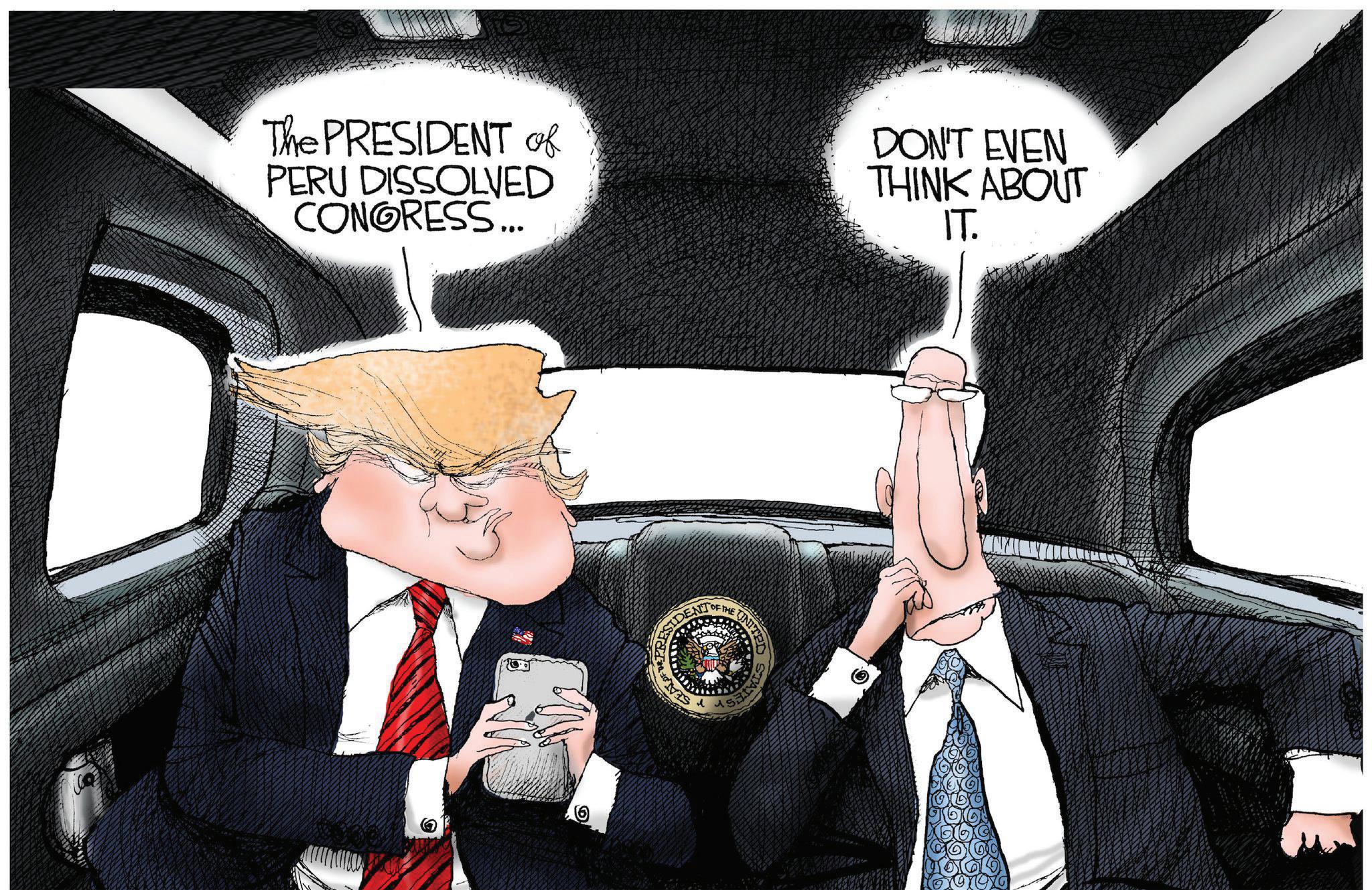
7 minute read
PERU’S CYCLE OF INSTABILITY
Peru’s ongoing political turmoil is symptomatic of more than just electoral distress linked as they are to a deep-rooted social alienation
SYNERGIA FOUNDATION
Advertisement

RESEARCH TEAM
Democracy in Latin America has always been threatened, and the trend continues. The region is a complex mix of democratic processes wherein many countries face challenges to their democratic aspirations. Still, some countries are successfully keeping democracy alive at home.
The pendulum of democratic rooting swings between an occasional populist leader with genuine democratic but socialist or left-wing leanings and extreme right-wing leaders with authoritarian inclination. State institutions like the security organs, press, judiciary and the executive consistently get infiltrated and, at times, remain at best mute witnesses, or worst-active participants, in the weakening or dismantling of democratic processes. Political polarisation, economic instability, and a trust deficit in government institutions have contributed to this distress.
In this milieu, Peru is no exception. Its experiments with democracy have been a mixed bag, perhaps owing to its complex socio-ethnic past. Peru is home to several socioeconomic groups with distinct ethnicity suffering from the legacy of its colonial past. The country continues to groan under a class hierarchy with those of lighter skin (typically of European heritage) usually belonging to the upper socioeconomic classes. This has invariably meant that darker skin or indigenous heritage is economically and socially disadvantaged.
The current wave of violent antigovernment protests, which sparked when interim President Dina Boluarte took office last month, reflects the historical divide in Peru between the rural, mostly indigenous poor and the ruling urban elites concentrated in the capital, Lima.
A Society In Conflict
A deep political divide marks Peru. Wealth is concentrated among a significant minority - those of European descent. These dominate the government and industry sectors, while those from a mixed racial background, commonly referred to as ‘mestizos’ and indigenous population, get pushed to the margins.
Peru is no stranger to conflict. The stark class differences were bound to result in a class struggle. Peru’s independence from Spain did not result in immediate transformation for Peruvian Campesinos or peasants who continued to toil as indentured labourers on plantations owned by elites until 1969. A series of bloody battles followed between leftist insurgents, state security forces, and paramilitary groups.
It is believed that when Che Guevara was despatched to Latin America by his partner Fidel Castro to light the flame of revolution, his focus was on Peru. The initial objective of Che Guevara was to strengthen the guerrilla struggle in Peru led by the Peruvian ELN in the
Ayacucho department. The idea to develop the Bolivian guerrilla war emerged after the defeat of the Peruvian ELN in December 1965 and ultimately Che died in a failed resurrection in Bolivia.
The internal conflicts of the 1980s and ’90s were marked by indigenous villagers carrying coffins through the streets and human rights groups decrying excessive government force. The commodities boom in the early 2000s did not see the easing of extreme poverty in many rural villages, which frequently lack access to basic sanitation, paved roads, schools, and hospitals.
The current wave of violent anti-government protests, which sparked when interim President Dina Boluarte took office last month, reflects the historical divide in Peru between the rural, mostly Indigenous poor and the ruling urban elites concentrated in the capital, Lima.
The lack of Indigenous representation in national politics is part of the problem. Unlike neighbouring Bolivia, where former President Evo Morales passed a constitution that empowered Indigenous groups and introduced quotas for Indigenous representation in Congress, in Peru, decision-makers are disproportionately part of the country’s white and mestizo elite. Inhabitants of Southern Andean regions tend to prefer anti-establishment politicians promising big changes.
Mr Pedro Castillo, the disposed and now jailed President, promised to remedy historical injustices with a new constitution and heavy spending on health and education. Instead, his 16 months in office were marked by corruption scandals, political and managerial missteps, and growing polarization. Typically, he blamed his troubles on Lima elites, many of whom tried to overturn the results of his election with unfounded claims of voter fraud.
Mr Pedro Castillo still has strong support from the rural and indigenous communities who view him as the victim of racist elites who don’t want to share power with him – and by extension, them.
The current unrest falls along historic rural-urban rifts – pointing to a yearning for political inclusion. Now, they are agitating for President Boluarte’s resignation, the closure of Congress, new general elections, and a new constitution.
“We feel we’re hated by those who govern Peru,” says Lucas Pari, a representative of the National Union of Aymara Communities, which supports the protests. “That hatred was always there, but now people are getting organized to demand respect for our fundamental rights to life, to equality, and to our identity.”
Democratic Overturn
Democracy has largely helped only a small elite in Peru — the powerful political class, the rich and corporate executives who have accumulated power and wealth while providing few benefits to the vast majority. Despite a significant sized population base that speaks Quechua, Aymara and other Amerindian languages, no major indigenous-based political party has risen to political prominence in Peru. Since the times of Fujimori, all Presidents have been centre-rightists, including Toledo (2001-2006) and Humala (2011-2016), who ran on moderate leftist platforms but, once in power, switched to centrist economic and social policies. Most Presidents, including the above-named, have been investigated for corruption from time to time, and some, like Fujimori, have served jail time.
Sadly, the ousted President, Pedro Castillo, who promised a breakthrough, did not fare any better while in power. His presidency was marked by controversy and political turmoil. In November last year, the Peruvian Congress voted to remove him from office following a no-confidence vote. The move came after a series of protests, strikes, and allegations of corruption and abuse of power.
Castillo’s working-class background was unprecedented in Peruvian politics, and his election in June 2021 against Fujimori’s daughter, Keiko, raised hopes that he would run an administration focused on improving the lives of the poor. His manifesto aimed to support poor Peruvians who the country’s stellar economic growth had left behind since the beginning of the century.
His time in office was not without turmoil, and his political career seemed to run from one crisis to the next. He reshuffled his cabinet multiple times and faced three impeachment attempts over corruption charges. He now stands abandoned by nearly all of his allies and even his lawyer!
Castillo doesn’t have much support abroad either. The U.S. embassy in Lima condemned Castillo’s move stating in a tweet, “The United States emphatically urges President Castillo to reverse his attempt to close Congress and allow democratic institutions in Peru to work according to the constitution.”
Mexico’s President, Andrés Manuel López Obrador, called for “democratic stability for the benefit of the people”. In a string of tweets, the leftist leader said that an atmosphere of “confrontation and hostility” had led Castillo to take decisions that ultimately served his opponents and led to his removal from office.
Castillo had attempted to change the constitution, which detractors claimed showed his disregard for the independence of the judiciary and separation of powers. His government had also been accused of violations with respect to human rights and political repression.
A period of instability in Peruvian politics seems to extend with Castillo’s departure. Boluarte is the country’s fifth president in just over two years and will govern with a Congress that is even less popular than Castillo.
A Deeper Malaise
The current unrest is symptomatic of more than anger over who runs the country. Peru’s young democracy seems to have failed its indigenous community, as demonstrated by protesters saying it has failed to address a yawning gap between the rich and the poor and between Lima and the country’s rural areas.
More broadly, the crisis in Peru reflects an erosion of trust in democracies across Latin America, fuelled by states that “violate citizens’ rights, fail to provide security and quality public services, and are captured by powerful interests,” according to a new essay in The Journal of Democracy.
Ms Boluarte ran on Mr Castillo’s ticket last year and was elected vice president. But she rejected her former boss’s attempt to rule by decree, calling it an authoritarian power grab, and promptly changed sides to replace her boss. In response to the recent protests, she has called on legislators to move up new elections and urged unity in response to protesters’ demands. Boluarte’s critics now call her a weak president working at the behest of a self-interested, out-of-touch legislature. Protestors had earlier demanded Mr Castillo’s reinstatement or new elections as quickly as possible. Their demands now embrace a broader vision encompassing a new constitution and even, as one sign put it, “to refound a new nation.”
Global Parallels
What is saving many Latin American democracies from “outright death,” according to Steve Levitsky, a leading expert on democracy at Harvard University, is that a viable alternative — like Hugo Chávez’s authoritarian socialism in Venezuela — has yet to emerge.Democracy has witnessed many global challenges over the past decade, and Peru cannot be singled out for strife and political turmoil. Even in the doyen of western liberal democracy, the U.S. – ex-president Trump’s reign and ultimate downfall amidst charges of rigged election results and refusal to quit office- left traces of cynicism.
Challenges to the integrity of the electoral process, and threats of violence from extremist groups have created a climate of uncertainty about the election and its aftermath, with worrisome implications for the longterm health of American democracy.
This weakening of trust is no longer unique to the U.S. and is referred to as ‘democratic backsliding’, a process which raises many questions about the durability of the institution. A similar concern has played out in other countries, from Viktor Orban’s Hungary to Jair Bolsonaro’s Brazil.
Assessment
Peru’s current crisis reflects its deeply divided social fabric marked by the alienation of its indigenous people. Former president Castillo exemplified this discontent, and his removal from office has therefore triggered violence and protests.
More broadly, the crisis in Peru reflects an erosion of trust in democracies across Latin America. Nation states have failed to protect citizens’ rights or provide security and quality public services. Power reflects powerful personal interests, and marginalized communities have remained at the periphery of economic growth and progress.
Clearly, while Peru has given rise to many noteworthy political movements, it has failed to build enduring political institutions to carry forward these noble ideas. This is mainly because economic power is so diffused, with neither side having the weight to enforce its philosophy, hence the reigning confusion.









